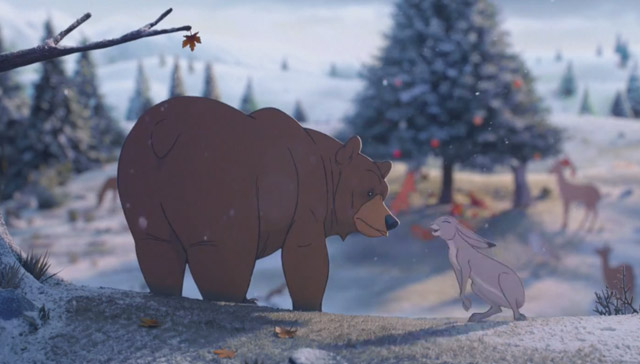Can adverts be art? Lucia Ennis gives her opinion on all the ‘artsy’ adverts that have hit our screens this festive season.
It’s John Lewis’s most wonderful time of the year . Their eagerly anticipated Christmas advert, featuring the #bearandhare, has created a bigger social buzz than ever before.
The traditional line-drawn ad (made from the artists behind the Lion King) premiered during an episode of X-Factor on the 9th November. On that weekend alone, the retail giant amassed a huge 86,300 ‘Bear and Hare’ related twitter mentions – up 29% from the opening impact of 2012’s advert ‘The Journey’.
In the last three months of 2013 retailers are expected to spend £390million on advertising – putting John Lewis’s campaign budget of £7million into perspective. Steve Sharp, M&S Marketing Chief, explains: “this is the golden quarter for retailers. This is make or break time – you need to throw all your efforts in”. As a result, many retailers have turned to ‘artistic’ advertising to give their brand a suitable Christmas flair – but can an advert ever be art? And would we want it to be?
For their part, M&S have enlisted models Rosie-Huntington Whitely and David Gandy to recreate famous fairytale scenes (Alice in Wonderland, Wizard of Oz) under the tagline “believe in sparkle and magic”. In a bid to crack social media, the companies twitter handle launched a campaign to name the dog in the advert, tweeting “Vote for Magic or Sparkle with #MagicorSparkle” – with ‘Sparkle’ ultimately receiving the most hashtags. M&S’s ‘mentions’, however, were still down on John Lewis’s, trailing behind on social-media chatter by 43%. A real-life dog hasn’t quite caught our hearts like the line-drawn hare has.
It’s not as bad as Sainsbury’s, who have been left cringing after making the embarrassing error of featuring Co-Op products in their advert. A spokesman for Co-Op responded that the company were “delighted” to have “made it” in Sainsbury’s advert, saying: “It seems that our Truly Irresistible Christmas pudding, lemon torte, and Christmas cake, are so good even Sainsbury’s cant resist advertising them”
But does good advertising actually translate into good sales? It certainly seems to have an effect. After John Lewis’s 2011 Christmas advert – titled “For the gifts you can’t wait to give” – sales went up on 2010’s figures by almost 10%. Managing Director Andy Street called the results “outstanding”.
Was this down to a stellar marketing campaign, or was it John Lewis’s crowd-pleasing policy “never knowingly undersold” that edged the gap? Or, moreover, the fact that John Lewis’s electrical guarantees extend to 2 years at no extra cost to consumer?
It’s interesting that John Lewis, for all its social buzz, is the only retailer to have relied entirely on artistic/emotional impact, without actually featuring any of the stores products in its advertisement. This bold tactic has worked: latest figures show a surge of 18.4% in sales in the week leading up to December. Customers have also flocked to the stores buying out #bearandhare merchandise – including everything from onesies and alarm-clocks to bear-claw slippers.
As for ‘artistic integrity’, it’s inescapable that the Bear and the Hare have ultimately been designed for the sole use of promotion– but this very ‘design’ is so effective that people don’t seem to care that it is one!
With its YouTube views already at over 7 million, the advert has certainly caught peoples attention. “[It] evokes the excitement of a first Christmas”, a John Lewis spokesman explains, as well as the “importance of friendship and thoughtfulness” in choosing a gift. It will also evoke a nice Christmas profit.




